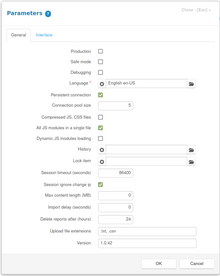Jam.py (web framework)
 Screenshot of Parameters, with the visual form editor being used to create an application | |
| Original author(s) | Andrew Yushev |
|---|---|
| Initial release | July 1, 2015 |
| Stable release | 5.4.136[1] |
| Repository | https://github.com/jam-py-v5/jam-py |
| Written in | Python, JavaScript |
| Platform | Cross-platform |
| Type | Web framework |
| License | 3-clause BSD |
| Website | jampyapplicationbuilder |
Jam.py is free and open-source low-code/no-code "full stack" WSGI rapid application development framework for the JavaScript and Python programming language.[2]
Jam.py is a Single-page, event driven low-code development platform for database-driven business web applications, based on DRY principle, with emphasis on CRUD. It is designed to automatically create JavaScript web forms from the underlying database tables, although a form can be created manually if required.
It offers a built-in web server, Application Builder and database access for third-party databases.
Features
- Single distribution which runs with both Python 2.6+ and 3.x
- Can run as a standalone web development server or be used with any web server which supports WSGI
- Built-in GUI builder called Application Builder
- Support for JSON client data (for REST and JavaScript clients)
- Support for popular databases Oracle Database, Microsoft SQL Server, PostgreSQL, SQLite, MySQL, Firebird (database server), SQLCipher[3][Note 1]
- Extensible authentication mechanisms and role-based access control
- Internationalization support
- jQuery for Ajax and UI
- Template language
- Reports Templates based on LibreOffice
- Files upload
Distinctive features
Built-in Application Builder
All development, maintenance and remote database administration can be performed via Builder interface. The most distinctive feature is the Client and Server Module. The Server Module enables the Python code for business logic, executed as a server-side session. The Client Module executes the JavaScript code within a browser. It is possible to exchange data between the two. [4]
Application Builder is strongly influenced by Delphi visual designer.[5]
Application Builder Client Module
The following JavaScript code shows a simple web page that displays "Hello World!" when visited:
task.create_menu($("#menu"), $("#content"), {
splash_screen: '<h1 class="text-center">Hello World!</h1>',
view_first: true
});
The above code resides in Task/Client Module(s) within the Application Builder. The task function can be accessed globally.
Application Builder Server Module
The Python libraries can be imported within the Task/Server Module(s):
import smtplib
def send_email():
# code that sends email
The above code imports smtplib library, which might be used to send emails. The defined functions can be accessed globally.
Database migrations
Jam.py supports database migration and data import from one supported database to another. The below code in the Task/Server Module will import data from SQLite to application database:
from jam.db.db_modules import SQLITE
def on_created(task):
task.copy_database(SQLITE, 'demo.sqlite')
Limitations:
- The SQLite database can not be imported into the application database which has foreign keys.[6]
PythonAnywhere
PythonAnywhere Python 3.x deployment is supported[Note 2]
Notes
- ^ "Database — Jam.py documentation". jam-py.com.
- ^ "pythonanywhere/help_pages". GitHub. 11 October 2021.
References
- ^ https://github.com/jam-py/jam-py/releases/tag/5.4.136.
{{cite web}}: Missing or empty|title=(help) - ^ "WebFrameworks - Python Wiki". wiki.python.org.
- ^ "SQLCipher". GitHub.
- ^ Building a database front end with Jam.py
- ^ Best Frameworks for Web Design
- ^ How to migrate to another database
See also
- Flask (web framework)
- Pylons project
- Web2py
- Django (web framework)
- Comparison of web frameworks
- List of low-code development platforms

